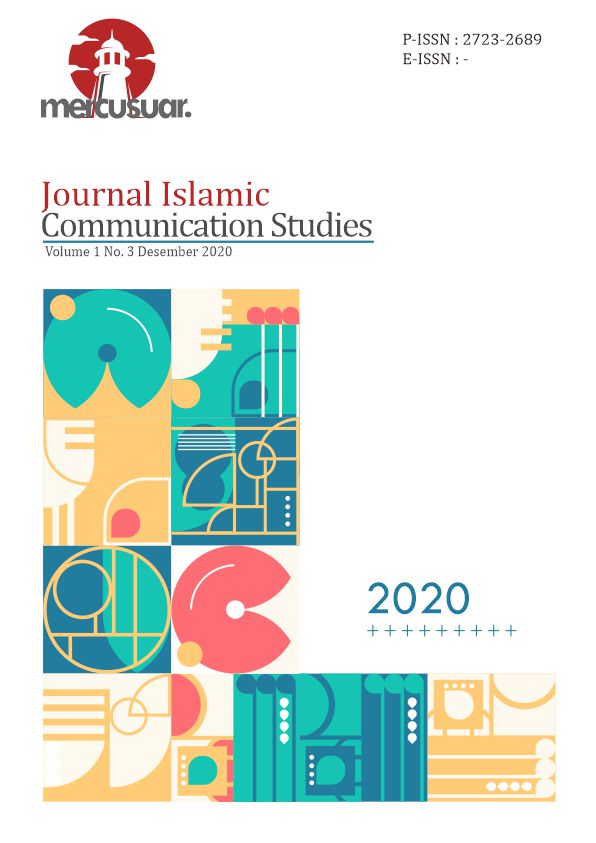Arts and Culture as a Medium of Islamic Propagation.
Abstract
Art is something that contains beauty, pleasure and everything that is interesting and enjoyable. Art is basically created to bring pleasure and beauty. Pleasure is a desire and preference of human beings due to the natural instincts blessed by Allah SWT, while beauty is a quality that refers to a person's feelings towards an object that contains aesthetic value. Throughout human history, no one has ever been found to distance themselves from various forms of art. On the other hand, Da'wah is a call to duty that is not determined by social structure, position or skin color differences, but for all people who claim to be Muslims. The task of Da'wah is adjusted to the abilities and skills of each subject of Da'wah, which means that not everyone has to engage in Da'wah activities like a preacher, orator, or khateeb, but is based on their abilities and expertise. An artist can propagate the faith through their artworks, as artwork is a medium of providing understanding to the community about the beauty of Islam.
Downloads
References
Abdurrahman, Soejono dan. Metode
Penelitian Suatu Pemikiran Dan
Penerapannya. Jakarta: Reneka Cipta,
Al-Qardhawi, Yusuf. Nasyid Versus Musik
Jahiliyyah. Edited by Tim Penerjemah
LESPISI. Bandung: Mujahid, 2001.
Asy’ari, M. “Islam Dan Seni.” Jurnal
Hunafa 4 (2007).
https://www.jurnalhunafa.org/index.
php/hunafa/article/view/207.
Baghdadi, Abdurrahman Al. Seni Dalam
Pandangan Islam : Seni Vokal Musik
& Tari. Jakarta: Gema Insani, 2004.
Beg, M. Abdul Jabbar. Seni Di Dalam
Peradaban Islam. Bandung: Pustaka,
Fitriyani. “Islam Dan Kebudayaan.” Jurnal
Al- Ulum 12 (2012).
https://journal.iaingorontalo.ac.id/in
dex.php/au/article/view/94.
Gazalba, Sidi. Islam Dan Kesenian
Relevensi Islam Dengan Seni Budaya.
Jakarta: Pustaka Al- Husna, 1988.
Hasan, M. Thalhah. Islam Dalam
Perspektif Sosial Kultural. Cet III.
Jakarta: Lambora Press, 2005.
Hoeve, Van. Ensiklopedi Indonesia.
Jakarta: PT. Ikhtiar Baru, 1990.
Kluckhohn, Kroeber dan Clyde. Culture: A
Critical Review of Concepts and
Definitions. Cambridge: The Museum,
Koentjaraningrat. Pengantar Ilmu
Antropologi. Jakarta: PT. Aksara Baru,
Kuntowijoyo. Muslim Tanpa Masjid: Esai-
Esai Agama, Budaya, Dan Politik
Dalam Bingkai Strukturalisme
Transedental. Cet II. Jakarta: Mizan,
Leaman, Oliver. Estetika Islam :
Menafsirkan Seni Dan Keindahan.
Edited by Abubakar Irfan. Cet I.
Bandung: Mizan, 2005.
Maharani, Esthi. “Kesenian Jadi Media
Dakwah Islam,” 2017.
https://republika.co.id/berita/ozp0u
h335/kesenian-jadi-media-dakwahislam.
Munawwir, Ahmad Warson, Zainal Abidin
Munawwir, and Ali Ma’shum. Kamus
Al-Munawwir Arab-Indonesia.
Surabaya: Pustaka Progresif, 1984.
Muriah, Siti. Metode Dakwah
Kontemporer. Yogyakarta: Mitra Pustaka, 2000.
Mustofa, Ahmad. Filsafat Islam. Bandung:
Pustaka Setia, 1997.
Nasr, Seyyed Hossein. Spiritualitas Dan
Seni Islam. Edited by Art and
Spirituatity terj. Sutejo, lslamic.
Bandung: Mizan, 1993.
Notowidagdo, Rohman. Ilmu Budaya
Dasar Berdasarkan Alquran Dan
Hadis. Jakarta: Rajawali Pess, 1997.
RAHARJO, M. QURAISH SHIHAB- SAPTO.
ISLAM DAN KESENIAN. Yogyakarta:
MKM UAD Lembaga IJtbang PP
Muhammadiyah, 1995.
Sanusi, Anwar. Metodologi Penelitian
Bisnis. Jakarta: Salemba Empat, 2016.
Sujarweni, V.Wiratna. Metodeologi
Penelitian. Yogyakarta: Pustaka Baru
Perss, 2014.
Sumardjo, Jakob. Filsafat Seni. Bandung:
ITB PRESS, 2000.
Toriq. “Beda Seni Di Mata Barat Dan
Islam,” 2015.
https://www.hidayatullah.com/artike
l/ghazwulfikr/
read/2015/01/27/37612/bedaseni-
di-mata-barat-dan-islam-2.html.
Tylor, Edward B. Primitive Culture:
Researches Into The Development of
Mythology, Philosophy, Religion, Art,
and Custom. Vol. 1. London: John
Murray, 1872.


